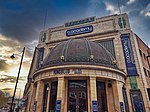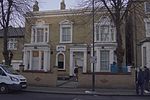Stockwell Skatepark
Parks and open spaces in the London Borough of LambethSkateparks in the United Kingdom

Stockwell Skatepark, also known as "Brixton Bowls" or "Brixton Beach", is a concrete skatepark situated on the corner of Stockwell Park Walk and Stockwell Road in the borough of Lambeth in South London. Construction of the park was funded by the Lambeth Borough Council in 1978 and it has been used since then by skateboarders, BMXers, rollerskaters, and assorted other self-propelled wheeled vehicle practitioners. The park is unsupervised and free to use at all hours, and has remained consistently popular throughout its life, both with locals and with visitors from all over the world.
Excerpt from the Wikipedia article Stockwell Skatepark (License: CC BY-SA 3.0, Authors, Images).Stockwell Skatepark
Stockwell Road, London Stockwell (London Borough of Lambeth)
Geographical coordinates (GPS) Address Website External links Nearby Places Show on map
Geographical coordinates (GPS)
| Latitude | Longitude |
|---|---|
| N 51.46641 ° | E -0.11596 ° |
Address
Stockwell Skatepark
Stockwell Road
SW9 9TF London, Stockwell (London Borough of Lambeth)
England, United Kingdom
Open on Google Maps









